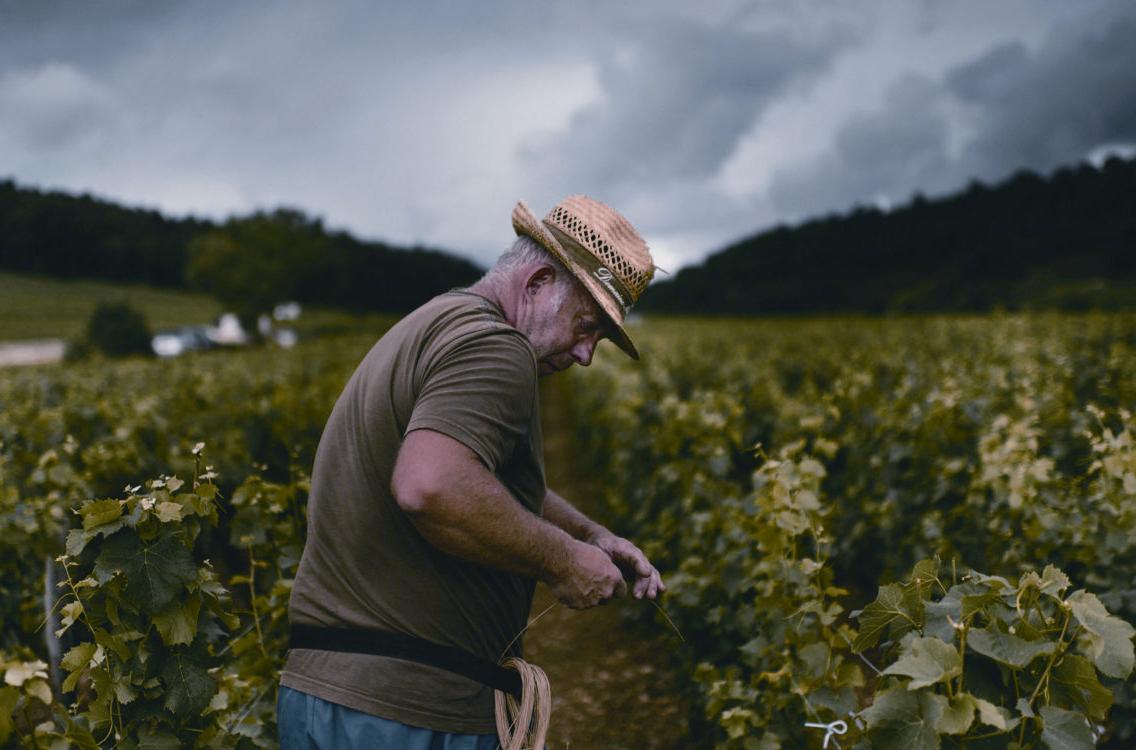当勃艮第遇到俄勒冈
Tersina Shieh

勃艮第與俄勒冈或许有着天壤之别,多亏让-尼古拉斯·梅奥这位勃艮第的凯慕思酒庄庄主兼俄勒冈的杰伊酒庄合伙人,才让我们有机会对大西洋两岸的黑皮诺作了对比。
Burgundy and Oregon maybe a world apart but thanks to Jean-Nicolas Méo, owner of Domaine Méo-Camuzet in Burgundy and partner of Nicolas-Jay in Oregon, we were able to compare the Pinot Noirs from both sides of the Atlantic Ocean during his recent visit in town.
让-尼古拉斯·梅奥家族所拥有的凯慕思酒庄位于沃恩·罗曼尼产区内。1989年,让·尼古拉斯在勃艮第完成酿酒的学习后,子承父业并开始在美国工作。在父亲让·梅奥和备受业界推崇的亨利·贾叶(Henri Jayer)的指导下,让-尼古拉斯尝试了多样的酿酒技术,并最终形成了自己的风格。相比整串发酵,他更喜欢去梗后再发酵,尽管在他经手的发酵中,可能也包括10%的果梗。葡萄在15 oC左右的低温下浸皮几天,接着在30 oC以下的水泥罐或不锈钢罐中发酵,然后温浸几天,最后再进行压榨以提取更多物质。根据葡萄的果皮结构,每款葡萄酒的陈酿方式不同。如今,该酒庄生产25款葡萄酒,包括勃艮第产区内的特级园和一级园。
我们一共品鉴了4款皮诺葡萄酒,所有2016年份的葡萄酒都来自于夜丘的不同村庄。与勃艮第独特的风土一样,这些葡萄酒也展现了不一样的个性。我喜欢Fixin细腻的香气和天鹅绒般的酒体,这是一个只有80公顷的鲜为人知的小产区。相比之下,它的邻居马沙内则是个广为人知的新型大产区,出产的葡萄酒有明亮的红色水果特征。我最喜欢的葡萄酒来自沃恩·罗曼尼产区,有多层次的香气并且非常新鲜。这两个地块的葡萄园紧挨着该家族的住所处,坐落在海拔较高的地方。相比之下,莫雷·圣·丹尼村的葡萄酒则酒体强劲,带有黑色水果气息和坚实的单宁。这就是勃艮第为什么如此独特的原因—每一个产区之间无论挨得多近,都有它们自己对于黑皮诺的诠释。
让-尼古拉斯30年前在美国认识了音乐制作人杰伊·博伯格。他们对于生活、葡萄酒、音乐,尤其是来自俄勒冈的黑皮诺有着相同的热情。最终,这两人在2013年创立了杰伊酒庄。让-尼古拉斯很高兴可以将自己在勃艮第学到的东西带到一个气候,并且土壤完全不一样的新产区。与勃艮第不同,俄勒冈春季潮湿,夏季干燥。这里的土壤、克隆品种,甚至是工作态度也完全不一样。勃艮第人更加凭直觉做事,而俄勒冈人则更靠技术。让-尼古拉斯谦虚地承认,自己还需要向美国的同事们学习。
目前,尼古拉斯·杰伊只生产黑皮诺。来自俄勒冈州威拉米特河谷产区的3个葡萄园里的葡萄被用来酿造三款单一园葡萄酒,而两款混酿葡萄酒则用来自整个山谷的葡萄来酿造。与勃艮第相比,俄勒冈的葡萄酒成熟度更高,有更多水果风味,但产自不同地块的葡萄酒仍有差别。2017年份的葡萄酒来自有机、旱作法种植的尼斯葡萄园,口感丰富、单宁柔顺。而同是2017年份,来自凉爽的、使用生物动力法种植的蒙塔奇葡萄园的酒款,口感则更加集中,更令人兴奋并且更有结构感。Own-Rooted Pinot Noir 2017是由至少30年树龄的非嫁接葡萄酿制而成。这款葡萄酒带有咸味,让人很期待它接下来会如何发展。让-尼古拉斯还向我们展示了2015、2016、2017这三个年份的Willamette Valley Pinot Noir,让我们比较不同年份葡萄酒的状态和变化。
我们唯一品鉴的一款白葡萄酒是来自凯慕思庄园的HautesC?tes de Nuits Clos Saint-Philibert 2016,这是一款宜人的葡萄酒,用让·尼古拉斯的话来说,就是介乎于夏布利和默尔索之间。它具有夏布利葡萄酒的新鲜和矿物质感,同时也有默尔索葡萄酒成熟的核果香气和丰富性。夜丘是一个红葡萄酒产区,但这个特别的葡萄园位于1200英尺海拔之处,是多石土壤。让-尼古拉斯解释道:在这个葡萄园生长的黑皮诺缺乏丰富性,产量也较小,但其风土条件却非常适合种植出色的霞多丽。
这两个酒庄相隔数千公里,采收期几乎是在同一个时候,经营起来并不容易。让-尼古拉斯说,他很幸运,因为自己可以信赖在当地的酿酒师特雷西·肯德尔。他每年都会去俄勒冈4次,而且都是在采收期间。勃艮第的采收期短暂并且时间紧凑,而俄勒冈的采收期则会持续一段比较长的时间,因此他还可以赶上俄勒冈采收期的尾声。
The family owned Domaine Méo-Camuzet is in Vosne-Romanée. In 1989, Jean-Nicolas joined his father after studying winemaking in Burgundy and a stint in the USA . With his father Jean Méo and well-respected Henri Jayer as his mentors, Jean-Nicolas experimented with different winemaking techniques and eventually developed his own style. He prefers de-stemming as opposed to whole bunch fermentation although he may include around 10% of stems during fermentation. Grapes are cold-soaked at around 15oC for a few days prior to fermentation in cement or stainlesssteel tanks at up to 30oC, then warm-soak for a couple of days before pressing for more extraction. Depending on the fruit structure, each wine is aged with different wood regime. Today , the domaine produces 25 wines, including Grands Crus and Premiers Crus form the region.

We tasted four Pinots, all 2016 vintages from different villages in Cote de Nuits. True to Burgundy distinctive terroir, the wines show different characters. I like the delicate aromas and velvety structure of Fixin, a lesserknown small appellation with only 80ha under vines. In comparison, its neighbour Marsannay, the latest, bigger and more well-known appellation, produces wine with bright red fruits. Vosne-Romanée, with multi-layered aromas and freshness, is my favourite. The two plots of vineyard, next to the family house, are located at a higher altitude. In contrast, the wine from Morey Saint-Denis is sturdy with a darker fruits profile and a firm tannin. This is why Burgundy is unique - every appellation, no matter how close they are, has its own interpretation of Pinot Noir.
Jean-Nicolas met music producer Jay Boberg 30 years ago when he was in the US. Sharing the same philosophies about life, wine and music and especially the passion for Pinot Noir from Oregon, the pair eventually founded Nicolas-Jay in 2013. Jean-Nicolas was excited to take what he learnt from Burgundy to a new region with different climate and soil. Unlike Burgundy, Oregon has a wet spring but dry summer. There are also differences in the soil, clones and working attitude. Burgundian is more intuitive whereas Oregonian is more technical. Jean-Nicolas was humble to admit that he also has to learn from his US colleagues.
At the moment, Nicolas-Jay only produces Pinot Noir. They source grapes from three vineyards sites in Willamette Valley in Oregon, make three single-vineyard wines and two blends using grapes from across the valley. Comparing to Burgundy, the Oregon wine is riper and more fruitforward but there are still variations in different sites. The 2017 wine from the organic, dry farmed Nysa vineyard is generous with a softer tannin while the same vintage wine from the cooler, biodynamically farmed Momtazi vineyard is more focused, uplifted and structured. The 2017 Own-Rooted Pinot Noir was made from vines at least 30 years old and planted on their own roots. The wine has a more savoury note and it will be interesting to see how it develops. Jean-Nicolas also showed us three vintages of Willamette Valley Pinot Noir, 2017, 2016 and 2015 to compare the different vintage conditions and evolvement.
The only white wine we tried was Hautes-C?tes de Nuits‘Clos Saint-Philibert2016 from Domaine Méo-Camuzet, a very pleasant wine that Jean-Nicolas described as a cross between Chablis and Meursault. It possesses the freshness and mineral character of Chablis and at the same time, the ripe stone fruits aromas and richness of Meursault. Cotes de Nuits is a red wine region but this particular vineyard is at an altitude of 1,200ft with stony soil. Jean-Nicolas explained that Pinot Noir grown there will lack richness and volume, but the terroir is just perfect for a remarkable Chardonnay. Running two wine estates thousands of kilometres apart and with harvests pretty much at the same time is not easy. Jean-Nicolas said he is lucky that he can rely on resident winemaker Tracy Kendall. He goes to Oregon around four times a year and definitely at harvest. Burgundy harvest is compact and shorter so he is able to catch the end of Oregon harvest, which spreads over a longer period of time.

